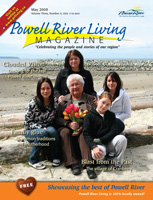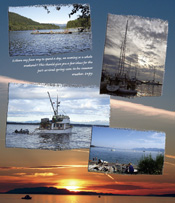>> This issue is also available as a 6MB PDF download
Table of Contents
Family Matters: Don't worry, be happy
Family Glue: Sliammon traditions and motherhood
Catch the spirit! Bruce Denniston Bone Marrow Society Spirit Run
Native son returns home: Sean Percy joins Powell River Living team
Cat Scan update: Donate your dividends
Faces of Education: Teacher brings chemistry to life
Blast from the Past: Remembering the Village of Cranberry
The most important job
For Art's Sake: Postcards from the Powell River Peninsula
Community Calendar
Explore Powell River
Have you ever noticed how some people always seem to be happy? They have a smile on their face, say a friendly hello and have this inner glow that’s hard to explain. Do you suppose it’s because they have no worries, no financial pressure or stress in their lives? Do you think it's because their lives are absolutely and positively perfect?
Or do you suppose that they have discovered how to live a positive and happy life? How to focus on the good rather than the bad?
We all have stresses and worries but some people are able to cope with them better than others. Some people can leave their jobs at the office and let go of troubling thoughts while others let problems eat away at them.
Letting go is one of life’s lessons that is often difficult to learn.
There’s this tale about problems that goes like this. If you had a group of people and asked them to throw their problems into a pile in the middle of the room and then choose a set of problems most people would dive in to get their own. It seems that as humans, we are more comfortable dealing with the known rather than the unknown.
In 2005 I was fortunate enough to win a Canadian International Development Agency journalism award. Because of this, I was given the opportunity to travel to Tanzania to learn about cida's international cooperation and development projects. I learned many lessons while in Africa and was struck time and time again by how happy and how genuinely friendly the African people seemed despite the fact that they were living in poverty. Politeness seemed ingrained in adults and children. Friendly smiles were everywhere. One phrase I heard time and time again that stuck in my mind was Hakuna Matata. This Swahili phrase means “no worries” and it was popularized around the world by the Disney movie, The Lion King, where living for the present and leaving memories in the past became a key phrase and lesson in the movie.
We make choices in life every single day. We can choose to be negative or angry or we can choose to be positive and happy. We can choose to see the good in people or we can look for the bad. We can begin the day in a grumpy mood because we weren’t ready to get up when the alarm clock went off or because it is raining and it was supposed to be sunny. But remember, one negative thought leads to another negative thought and if you let it, pretty soon your whole day will seem like an insurmountable chore.
Begin the day in a positive frame of mind, smile at the world and the world will smile at you.
It’s all about attitude. Change your attitude, change your life. So when you get up tomorrow morning ask yourself, “Am I going to be the kind of person everyone wants to talk to or will I be the grouch? Your attitude will go a long way toward determining how your day goes.
Family Glue: Sliammon traditions and motherhood
By Janet May
“Tell her about the belly buttons, mom,” says Marlane Christensen and we become children again waiting for the story. Elsie Paul settles in her chair and begins. “We do this today,” she explains, “We take the piece that falls off the newborn baby’s belly button and we don’t throw it away. We dry it out and seal it in a tight container and bury it in a safe place where animals can’t get it. That is the root or the anchor for the child. That shows where that child belongs and the child will always come back. In the past, when babies were born at home, we used to do that with the afterbirth.”
Marlane Christensen and Elsie Paul tell me that the umbilical cord represents lifeblood. By keeping it safe, the family is also caring for the spiritual health of their child. “It is an old tradition and has been practised for a thousand years or more,” says Marlane. Elsie affirms, “These traditions are the glue for our family. They are very meaningful.”
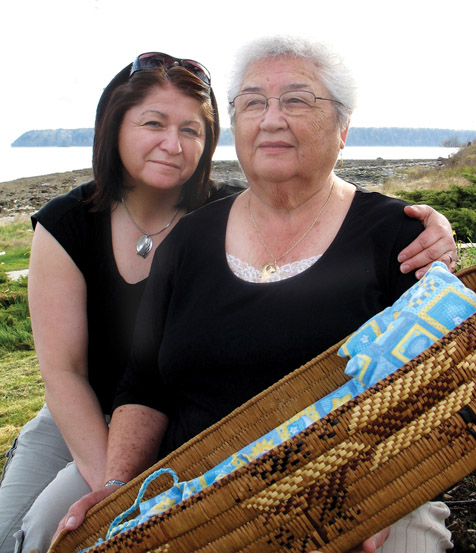
Six Generations: Elsie Paul holds the baby basket that her
grandmother made from cedar and cherry barks.
Elsie's daughter Marlene Christensen (left) is grandmother
to the most recent baby that slept in the basket:
Elsie's great-grandson Greydan, son of Jordan Mitchell
and Cindy Lessard. The basket has seen
six generations from Elsie's grandmother
to her great grandson.
Sliammon First Nation traditions did not include a day to celebrate mothers. Instead, Elsie tells me “we would celebrate motherhood everyday. Mothers and grandmothers worked around the home and looked after many children, not just their own. There were always lots of kids in the village. If the women went out berry picking or in the canoe, they would bring their babies with them.” Babies were carried in cedar root baskets and placed nearby while the women worked. These beautiful baskets are a tangible connection to the past, and Elsie treasures the basket that her grandmother wove for her daughter Jeannie. All the babies since have used it. The most recent resident was Elsie’s first great grandchild Greydan Lessard Mitchell, born October 2006.
Generations of family surround Elsie in her living room. There is a painting of her grandparents by Debbie Dan, and 16 grandchildren in a row watch her from above the window. Many of the grandchildren are a similar age and grew up together, more like sisters and brothers than cousins. Marlane laughs and tells us that her nephew “Cody calls me auntie mom.”
Marlane has friends from outside Sliammon whose families are scattered and haven’t seen each other for months or years. She can’t imagine living like that. “Our culture evolved around the nucleus of the family,” Marlene explains. The elders were the teachers, not in a classroom, but by doing things with the children and telling stories that illustrated a respectful way to live. They taught children what was expected of them. “Grandparents were the educators and the parents were the workers. That is critical to keep our society healthy.”
I have to bring it up. We need to talk about the residential schools. Both women nod sadly. “That was very bad for our families,” Elsie says, “It is not any one person’s fault, but it happened and we must acknowledge it. And we need to heal.” “It was a crushing blow to our society,” continues Marlane, “It took away the purpose of life for a grandmother. What is the purpose of life of a mother, if your children are going to be taken away to be brought up by someone else? I feel so protective of my grandson, I cannot imagine letting him go, letting him grow up away from family.”
Residential school students were removed from the family nucleus and had no adults to nurture them with hugs and loving words. The children were beaten if they spoke their language and girls were not allowed to speak to their brothers at all. They grew up without learning about their culture and without learning parenting skills. “ I have heard a man with tears in his eyes remembering how he had not known how to show affection to his own children,” says Marlane, “This damage will continue into the next generation.” Recently the Canadian government acknowledged the past harm and is beginning to hear from people who have suffered. Elsie and Marlane agree that it needs to be done sensitively, recognizing that the revelations will bring hard feelings forward and that the survivors and the whole community will need emotional support.
Elsie went to residential school for one year only. For the rest of her childhood, she was brought up by her grandparents, experiencing many of the ancient traditions. For Elsie, territory, family, and culture are interwoven. It is hard for her to see her children and grandchildren leaving Sliammon for work and schooling, but she knows that the world is changing and she is proud of their confidence and drive. “I know that they will have a different way of earning an income. I am very appreciative that they are interested in the culture. They are very respectful of our teachings.”
Elsie Paul’s traditional name, Qaxustala’s, means a welcoming person, with a wealth of knowledge, who shares her culture. Elsie embodies that meaning for her family and the greater community. “There is more to life than making ends meet” she reminds me. Satisfaction and inner peace are a kind of richness; family ties are wealth. “My family is very close knit, and I am very thankful for that.”
Catch the spirit! Bruce Denniston Bone Marrow Society Spirit Run
By Bill Whyard
My family and I moved to Powell River from Whitehorse, Yukon in the fall of 1989. Bruce Denniston had died in February 1989 and, when we arrived, there was still talk of Bruce Denniston and whether or not the old RCMP station on Marine Avenue had somehow contributed to his demise. I was impressed that the Bruce Denniston Bone Marrow Society had been started as a positive reaction to the loss of Denniston.
I have been running recreationally for years as I find a physical workout at lunch hour to be healthy.

When the society started the Spirit Run it appeared to me to be a great fundraiser. Its various distances, (5 km, 10 km and half marathon) were also attractive and I did my first Spirit Run in 2002, the second year it was held. It seems the event has grown each year and since it is a fundraiser I round up pledges before each run.
The eighth annual Spirit Run, which will be held on May 11 this year, begins at 9:30 am (for more information visit www.dennistonsociety.com or call 604 485-8488) is a pleasant family event and I particularly like the fact that it is a run and not a race. For me, running is an individual sport that gives me time to think about things. For the Spirit Run, I can reflect on Bruce Denniston and how his loss was turned into a positive thing, namely the Society and its fundraising components like the Spirit Run. Also, because this activity is not a race, participants set their own pace and, or course, the route is located on the Willingdon Beach Trail which is a lovely place to run.
It is a great event and anyone considering joining should do so. It’s a good way to ease into running (or walking) but don’t forget it’s also a fundraiser. So pick up a pledge sheet, knock on a few doors (most people willingly support this cause) and join the Spirit Run.
Native son returns home: Sean Percy joins Powell River Living team
by Sean Percy
Why he left his home in the South to roam ‘round the Pole, God only knows.
—Robert Service, in The Cremation of Sam McGee
There are a million reasons for a Powell River boy to come home. Mine are aged two and four.
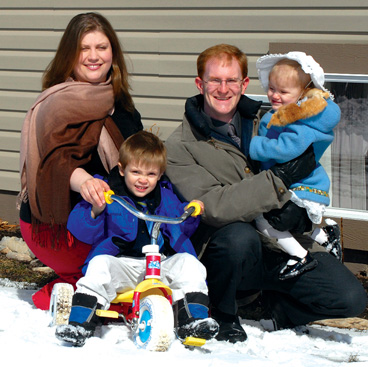
The Percy Family in Hay River, NWT. From left
Lauri, with Isaac, Sean and Ella.
Though I have not lived in Powell River for almost a decade, it has always been home. My time away has been spent in the little community of Hay River, Northwest Territories (population 3600). Each summer, and occasionally in spring and winter, I returned to Powell River to visit friends and family, and, twice, to be with my wife when she bore our children where we could be close to family. I was born and raised here. My parents are here. My wife’s parents and siblings are here. So the decision for us to move back to Powell River is far from surprising or unexpected.
However, as I prepared to leave Hay River, I realized that a piece of me will remain in the North. Northerners often say that if you make it three winters in the North, you’re a lifer. While that’s clearly not true in my case, I can see why they say that. Leaving the North was not easy. Robert Service wrote of the North, “There’s a land—oh, it beckons and beckons, And I want to go back—and I will.” And I suspect he’s right. I’ll probably go back to the North, but only for a visit.
Powell River has once again become home, and I couldn’t be happier to have it so.
Firstly, I’m thrilled that my daughter, who turns two years old this month, and my son, four, will grow up close to their grandparents. There’s a heritage they can receive from their grandparents that is very special. Add to that the free babysitting available from grandparents, uncles, aunts, and cousins, and we have a winning team. If parenting were a hockey game, we just got backed up by the entire lineup of the Pittsburgh Penguins (sorry Ottawa fans.)
Secondly, there’s the living in Powell River. Unlike many of my schoolmates, who couldn’t wait to get out of town, I knew that even if I left, I’d one day come back to this beautiful community. And I have. Twice.
I first left in 1994 to spread my wings, both with a career as a reporter and to serve where there was a greater need for Jehovah’s Witnesses, in Hay River, Northwest Territories. But I lasted only a year in the North, as my roommate’s sister caught my eye and lured me back home to Powell River. We were married in 1997. Fortunately, the Powell River News was willing to take me back again, this time as a senior reporter. Two years later my wife and I decided it was time to really head out on our own, and again we looked North. I left the Powell River News for the second time in 1999, and that venerable newspaper closed down just a few months later.
The Hub, the newspaper in Hay River, also took me back, this time as managing editor. Since the publisher had moved to Calgary, I was left to more or less run the place, and oversaw the shift from darkrooms, film and wax paste-up to digital cameras, computer pagination, direct-to-plate printing and full-colour reproduction. I picked up a lot of experience, knowledge, and, if I may toot my own horn a little, a fistful of newspaper awards in categories from feature writing to sports to advertising to photography. We even operated a little photo studio on the side.
The Hub also gave me the chance to experience what I had previously viewed as the “dark side” of publishing—advertising. But the more time I spent with advertisers and the business community, the more I realized how important that information was to readers. Whereas we in the publishing industry draw clear lines between “advertising” and “editorial,” most readers don’t make the distinction in the same way, and with good reason. Advertising is information important to readers. The store hours or sale details can be just as important to one reader as the insightful article on the latest industrial or social development may be to another.
Isabelle Southcott was a former co-worker at the Powell River News, and I had always viewed her as a bit of a big sister. When she headed out on her own to build Powell River Living, I was delighted for her, and offered what little gems of knowledge I had gathered in my northern experience. I was also, I admit, a little jealous. The magazine seemed like such an exciting project. So when the opportunity arose to join the team with my move back to Powell River, I was thrilled.
In the coming months, I’ll help connect you with some of Powell River’s great businesses. I’ll also share with you some diving and outdoor recreation activities, and other adventures in Powell River living.
It’s great to be back.
Cat Scan update: Donate your dividends
By Isabelle Southcott
Powell River’s Marg Simonetta has come up with an innovative fundraising idea for the CAT Scan Campaign.
When the provincial government issues its $100 carbon tax rebate (climate action dividend) in June of this year to every man, woman, and child, Simonetta proposes that everyone in Powell River takes that cheque and donates it to the CAT Scan fundraising campaign.
“When it was announced that we would all be getting $100 from the government my first thought was I will donate mine to the CAT Scan campaign. I am putting out a challenge to all citizens who use our local hospital to do the same because every penny helps.”

CAT Scan Campaign treasurer Ken Needham hopes the idea catches on.
“We really hope we can get some response from this. I was quite thrilled when I heard that Marg was involved with this and wanted to promote this whole issue.”
Needham says that people can donate their climate action dividend cheque at any local financial institution and the First Credit Union.
“They can go in and sign it over to the CAT Scan account or send us their own cheque,” says Needham.
Climate action dividend cheques or any other donation can be sent to the Powell River General Hospital’s CAT Scan Campaign, 5000 Joyce Avenue, Powell River, BC V8A 5R3 or call 604 485 3211, ext 4349.
Other CAT Scan Campaign fundraisers taking place include a book sale fundraiser featuring quality used books from Harbour Publishing on June 19 and 20 from 10 am to 4 pm at Nicholas Simons Constituency Office, #109-4675 Marine Avenue.
The Powell River Festival of Writers held a silent auction and raised $391 for the CAT Scan project thus proving that you don’t need a huge amount of people to hold a fund raiser, said festival president Barb Rees.
At the May 10 CAT Scan Campaign fundraising dinner at the Italian Club, the Brooks Jazz Combo, composed of grade 11-12 students have volunteered to perform.

Teacher brings chemistry to life
Passion, enthusiasm and a willingness to teach outside the box are just three traits that make Brooks Secondary School’s Colleen Balzer a special teacher.
“I love what I do. I tell my students at the beginning that I am very passionate about what I do,” Balzer told Powell River Living Magazine.
Balzer grew up in Australia and Brazil. “I was a missionary kid,” she says. Her family was based out of Vancouver and she studied at Simon Fraser University, earning a degree in Chemistry. “I did Co-op education in a number of industrial labs and it showed me what I did not want to do. It showed me that I needed to get out of the lab and that I needed to talk!”
After teaching mini university for a term Balzer realized that she loved teaching kids chemistry.
“I loved up blowing up things,” she joked.
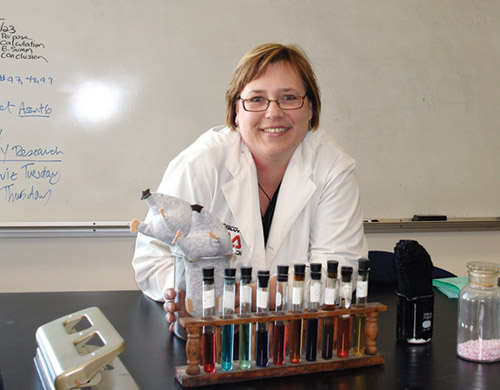
Chemistry teacher Colleen Balzer loves teaching
and sharing her passion for chemistry.
Balzer began teaching in Powell River in 1993. She teaches Chemistry 11 and 12, Math 10, Science 10 and BOSS 10 at Brooks.
“BOSS is a learning strategies class for helping students achieve their full potential. It is based on teaching students good strategies to be successful. BOSS is a three-year program that begins in Grade 8.
Balzer says she uses many BOSS strategies in teaching her other classes. For instance, she uses a technique called Cornell Notes in teaching Chemistry 11. “It’s a specific note taking process that helps students learn,” she says.
Balzer is passionate about chemistry. “There is work to it but it can be fun. I bring that into my class.”
Her grade 11 class celebrates Mole Day each year. “It’s about Avogadro’s number 6.02 x 1023. On October 23 from 6:02 am to 6:02 pm we celebrate this number.”
“Avogadro’s number is really important in that it quantifies chemistry. So we pledge allegiance to the mole (number) and we talk about how important that number is because without that number we could not do the chemistry we do today. We sing silly songs, we run about the school saying ‘Happy Mole Day’ and students have to explain what Avagadro’s number is. It raises awareness and I tell the kids it’s just a nerdy way for science geeks to have fun.”
Balzer wants to remove the mystery from science and make people realize that science isn’t boring. “Chemistry can be really dry. There’s a lot of math and notes and more math. You need something to spark it up a bit.”
For math students, Balzer holds Pirate Math Day. “I teach Math 10 and this is a way to make trigonometry interesting.”
Students spend about four classes preparing for Pirate Math Day. They make pirate maps with bearings and compasses and on the actual day itself they solve each others’ puzzles (the maps).
“I do the master map and hide gold coins that they can trade for goodies. We dress up. It’s a way to celebrate and have fun with some of the stuff we have to do.”
Balzer says there’s a lot of material to cover and it can be overwhelming. “This helps kids relax a little.”
In between it all, there are labs and demonstrations. “Our school board really supports the value of hands-on learning. They promote the ability for us to do meaningful labs and hands-on activities.
Balzer also has a section in Chemistry 11 where students participate in a forensic analysis lab. It is based on a crime scene. Photos are taken of the “victims” and on each victim there are traces of lipstick, white powder and ink. The scene is set and there are three suspects. “The kids come in, they’re given a report and there are crime scene pictures. They have to analyze the lipstick, white powder and ink. They are given an analysis sheet and have to come up with the answer.”
Bringing science to life is what Balzer loves to do. “A lot of my students who have gone on to study chemistry have been girls and they are really enjoying the careers they are heading into in chemistry.”
Balzer is married to Tim who is finishing up his PhD in military history. They have two sons, 6 and 10 years old. When Balzer isn’t busy teaching, she is juggling family life yet she still manages to find time to make homemade bread—something she perfected while walking the line when the teachers went on strike a few years ago. “I knew money would be a little tight so I started making bread. I made it every day for two weeks. I walked the line with my friend, Carol Cawley, the home economics teacher, who helped me.”
Balzer still has fun with her bread. “I barter it for eggs and have even bartered it for wine. It’s a good gift and I’ve brought it in for staff who need a little pick me up.”
And kneading bread is always therapeutic especially before or after a busy day in the chemistry lab.

The village of Cranberry Lake
By Gerry Gray
The village of Cranberry Lake was dragged, kicking and screaming into the 1955 amalgamation of the four communities (Westview, Townsite, Wildwood) to form the Municipality of Powell River. The reason for the reluctance was that Cranberry had $4,200 in the bank and the other three had none. Therefore, the question was “What’s in it for us?” For 10 years after the event, village seniors met every Saturday morning at Jack Hanna’s Quality Printing shop to bemoan the loss of Cranberry’s independence and how the folks in Westview were ripping them off. The same complaints were aired monthly at the Cranberry Ratepayers Association meetings. However, most were ignored at the council table.
For years Cranberry residents enjoyed telephone service, a good water supply, paved roads, a transparent village commission and a strong tax base. Businesses thrived in the community of 1,500 (1955 census) with its well-stocked general store (Bosa Mitchells); a bowling alley, pool hall, a roller skating rink and in the wintertime an outdoor ice rink on Cranberry Lake.
The community was incorporated as a village in 1942. First commissioners were Ray Weaver (to become first reeve of the Powell River Municipality), Norman MacIntosh, and Jimmy Ford (replacing Al Alsgard). Helping the commission run the village were Jack Brooks, H.J. Parry, Archie McKenzie, Bon Gela, Ernie Liebenschel, R.S.W. (Bob) Johnson, secretary who eventually became the first secretary of the future municipality.
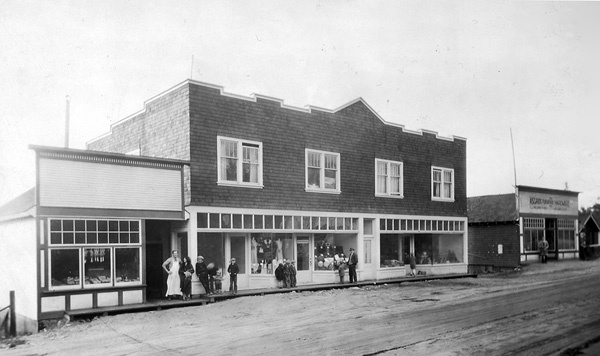
Downtown in 1931
In the early 1930s the Cranberry Ratepayer’s Association came into play and as Bessie Banham, the reigning scribe of the era remarked: “The organization was noted for its lively meetings.” That description would fit even today. The formation of the association was held in the home of Mr. and Mrs. Robert Tracey. The executive chosen was Archie McGeachy, president; Mrs. Tom Haddon, Vice-president; and charter members were Ernie Liebenschel, Ed Bernier, Henry Culos, H.J. Parry, Ernie Maple and Ernest Brooker.
The organization started the ball rolling to obtain light and water for the district when, in 1930, electricity became available to the outlying district from the Powell River Company. This initiative resulted in the formation of Cranberry Light and Water District. H.J. Parry, Arthur Longstaff and Eddie Goddard were the first trustees.
Cranberry Lake gained its name from the lush berries that flourished in the marshy lowlands surrounding the small body of water. Sliammon people had harvested the fruit for years before three prospectors; George Smarge, Magnus P. Olson and George McFall came looking for mineral deposits in 1910.
Early Townsite settlers soon found that the juice from the cranberries was a welcome addition to their sparse supplies, which came up the Coast by barge and scow from Vancouver or Seattle. However, there was plenty for all, even the bears who came out for a feed. Meanwhile the three intrepid prospectors discovered a likely deposit and filed a claim for a 52-acre mineral claim. A road was pushed through but the enterprise failed after the claim was cancelled when the mining inspector found the deposit was mica, not feasible for mining.
The road they constructed to connect with the Townsite proved to be the incentive pioneers needed to look at the area with a view of building homes. An orchard was planted where the veteran’s houses now stand and soon a farm came into being supplying the settlers with fresh milk and meat. Cranberry was on its way!
One of the attractions for people to move into the community was it was far enough away from the noise and smell of the mill which by this time was well underway. Another was the land was cheap and there was plenty of it. Smarge was one of the first to build then his partner McFall constructed a house nearby. Unfortunately, both houses were destroyed by fire in 1915.
Undaunted by the loss Smarge moved to Wildwood while McFall built on the other side of the lake, planted another orchard, raised pigs and established a dairy. Owing to the shortage of milk McFall only sold to mothers with babies. Nobody gave up easily in those early days when “make-do” was the order of the day.
Perhaps the most significant event that ensured Cranberry’s future was the start of the Cranberry Road, connecting Poplar Street in the Townsite to what was to become the main street of Cranberry. If anyone today complains of potholes, they should know what their forefathers put up with on the road to Powell River. It was built over mud and sand. Over the bog at the top of the hill 18-foot cedar blocks were put down to add some stability to the road. Planks were laid over the mud and when it rained these boards became rafts. If a driver let his vehicle slip off a plank it was a days’ work to get it back up. However, it was a passageway no matter how crude, and commercial vehicles were able to access scows and barges to take their wares to the marketplace. The road worked the other way also and new entrepreneurs started businesses that flourished as the area population increased. In 1915, Mowat and Wasser built a shingle mill at Mowat Bay. A road was built to connect with the fledging Cranberry Road so the product could be shipped by scow to Vancouver. Unfortunately the mill, which employed five men, shut down in 1919.
Dr. C.R. Marlatt bought the company and built a lumber mill on the site. With the increasing population needing houses his company, Local Lumber Co. Ltd. supplied most of the lumber. However, when the timber from the Edgehill district ran out logs had to be hauled with a donkey engine from Powell Lake and the added expense forced the mill to close.
The first subdivision development was Parryville, built by H.J. (Bert) Parry who arrived in town from Vancouver in 1922. He purchased adjacent to Lot 450 and pitched a tent for the family to live in until he could build a house. Houses were at a premium at that time so Parry put in a few small cottages and rented them out. Nearly everyone who came to Cranberry in those days spent some time in Parryville, which became the center of town.
His next venture was a business block built in front of his home facing Cranberry Road. Four stores moved in and Cranberry had a business center.
The stores were Haddads Dry Goods, Farrara’s Grocery Store, A. Smith, a butcher and Alsgard Furniture Store (which burned down in 1929). Because of the lack of available water in the district many homesteads were destroyed by fire. Fires became so frequent that a volunteer fire department was organized by Ernie Liebenshel. He became the first chief and businessmen purchased hoses and equipment. Later a truck and more equipment were purchased. Soon W. Jamieson, an engineer, designed a water distribution system.
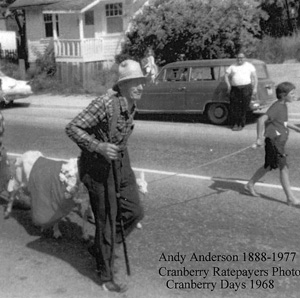
Around this time, a telephone system was planned but ran into difficulties from regulations banning the use of telephone poles because of high voltage. However that was overcome and a deal was cut. BC Telephone Co. would bear the expense of cutting down the voltage and the district would pay the cost of changing the transformers. Thus, Cranberry had the first telephone system in Powell River.
By 1929, Cranberry could boast of a complete shopping district with 21 business establishments. Liebenschel’s Transfer and Coal business, Scotty’s Transfer Co. and later Overwaitea Cash & Carry store added to the established businesses like Tom Ahola’s Hardware Store, Adolph Smith’s Butcher Shop and others.
In about 1945, Al Alsgard, publisher of the Powell River News and Town Crier, made a disquieting suggestion. In an editorial he floated the idea of amalgamation of Powell River, Westview, Cranberry Lake and Wildwood. The Powell River Co., which was going to get out of the real estate business because of the high taxes, supported this suggestion to have the Townsite assume municipal responsibility.
The idea grew legs and soon amalgamation was on everyone’s list of things to think about. Over the next few years’ meetings were held in the four communities, which would be affected. Pros and cons of ratepayers and village committees were discussed and finally, after nearly a decade, a caretaker council was named on Oct. 15, 1955. W.G. Harris was elected reeve of this council. Other members were: J.S.P. Johnson, B.M. Macintyre, Ed Bernier and R.S. Lyons. A date (Dec. 21) was set for an elected municipal council. Ray Weaver nosed out J.P. Dallos for the office of reeve. Others elected were Molly McLaren, Jimmy Court, Bob Gela, both Cranberryites, and Ted McComber.
When the municipality was settled in and started spending money Cranberry Lake’s worst scenario came true. On a per capita basis, Westview used the lion’s share putting in roads, water systems, streetlights to new subdivisions and not much came back to Cranberry even though $4,200 was their contribution.
However, it was a self-contained community and what had to be done they did themselves and that made Cranberry unique. Self-contained and willing to help their neighbours. That sense of togetherness still holds true and was exemplified in the summer of 1967 when the first Cranberry Days were held at Lindsay Park.
This was an idea that emanated from the Ratepayers Association and carried out by members of the community. To raise money for the event Cranberry businessman donated $1 a year. That money meant ice cream; hot dogs and pop could be sold at 1930 prices. A parade through the streets of the village to Lindsay Park was well attended and most of the community marched along with it. At the park there were bathtub races, tours of the Lake aboard Charlie and Gerry Parsons’ houseboat “The Queen of Cranberry” and swimming races at Whytes Beach. A great day.
Another annual event was the Park Avenue baby parade, a showcase for babies born since the last parade. Parents dressed up, balloons floated over the crowd and citizens from other communities dropped by for the celebration.
One last word on the Amalgamation. A quote by James D. Baird, deputy inspector of municipalities from Victoria: “Local government is the cornerstone of democracy in the nation. Only by a strong and united local administration can we hope to have a healthy municipal, provincial or federal government.”
The most important job of all
By Wendy Adams
I have often pondered the fact that in our society, we need a license to drive, a license to hunt, car dealers have licensed mechanics to fix our vehicles, a University degree and certificate to teach—every occupation I can think of has some amount of training. We even prepare expectant parents for giving birth, providing free prenatal courses. In the hospital you are taught how to feed, change and bathe your newborn. Then there are the follow up visits to weigh, measure and assess the baby’s general health. But then what? When it comes to actually raising our children, one of the most important jobs of all, our society doesn’t provide any formal training in being a parent.
If there were a course in parenting, what would a parent need to know? What can we teach prospective parents about raising their children? What is really important?
| The answers to my questions came to me at a most peculiar spot—at an awards assembly last spring. Each month we recognize the students for various academic and social achievements. This particular month our focus was Critical Thinking Skills. Being the grade one teacher, I sat and watched the other teachers present their awards (they save the best for last I tell my students). Many of the students I had taught in years past were recognized, not for the first time. | Each month, Powell River Living Learn more from Jim Petrie, 604 485‑4355; or Kevin Wilson, 604 483‑9052. |
I started to look at the audience—the parents of these thinkers’. We as teachers are certainly responsible for providing an environment that allows children to use their thinking skills, but I know that we cannot take full credit for our great thinkers, they came to us with the skills they needed before they even entered kindergarten.
Finally, it was my turn to honour the students in my class with their certificates. I walked my six little ones to the front of the gym. And then I felt myself stepping up to an imaginary ‘lectern’. I faced the parents and said:
As we recognize these children today for their critical thinking skills, we also need to recognize the parents as you are the first teachers of your children.
You have nurtured them and cared for them.
You have talked to your children about the world around them—creating a wealth of background knowledge.
You have listened to them.
You have allowed them to play and have played with them.
You have given them opportunities to explore and have explored with them.
You have read to them.
And you have loved them.
It is for all of these things you have done, as the first teachers of your children, that we are able to honour them today with this award. It is for this that we thank you.
I turned and quietly stepped down from my imaginary podium. At first I felt somewhat embarrassed, delivering a sermon no one asked for. But I felt some comfort in finding an answer to some of the questions I had been pondering. I now know what every parent needs in order to do the most important job of all.
Talking, listening, playing, exploring, reading, nurturing, caring and loving.
Ursula Medley kicks off May with her brand new show, First Impressions. Medley captures her impressions of nature and people in a loose, transparent and immediate painting style. Using oil on canvas or board, her work reflects deep roots in art historical influences.
“When I was a young girl I framed an art post card by Van Gogh and hung it in my room. Over a half century later I am reading Van Gogh’s letters and realize how his work still inspires the artist in me,” says Medley.
Van Gogh describes his method in a letter to his brother:
“…if I want to dash off an impression in an hour’s time I am learning to do so in the same way as others who analyze their impression, and who account for what they see. It is pleasant work to dash off something in a rush.
To paint in one rush---as much as possible in one rush! What struck me most on seeing the old Dutch pictures again was that most of them had been painted quickly….dashed off a thing from the first stroke, and did not retouch it very much.
The best pictures, and from a technical point of view the most complete, when seen from near-by are but patches of colour next to each other, and give an effect only at a certain distance.”
(From Dear Theo: The Autobiography of Vincent Van Gogh, edited by Irving and Jean Stone; Grove Press NY; p360.)
Medley often challenges herself to begin and finish a work in an hour. In doing so, she has been called “a Tom Thompson for our times” by Art Historian Ann Rosenberg. Thompson captured the relationship between nature and people with deliberate brushstrokes and liberal amounts of paint, achieving controlled spontaneity in his images of Algonquin Park—a strong influence with the artists who were to become the Group of Seven.
But Medley’s style is more akin to that of the French Impressionist Monet than any member of the Canadian Group of Seven, driven to capture a fleeting moment—a first impression.
In addition to her small plein aire landscapes, Medley produces still lifes and larger-scale art in her home studio, where she often gives classes in old master oil painting techniques. She is also currently working on a series of Lang Bay Amazons, women of the woods who sometimes wield chainsaws. Rubens’ voluptuous paintings of goddesses from the 17th century and Lucien Freud’s more recent renditions of mature women are among the art historical influences on this on-going series. Consult www.ursulamedley.com for more facts about Medley’s art & workshops and to view the exhibition.
An Art Slam promises to be another fabulous event for Powell River’s art scene. Megan Dulcie-Dill and Barbara Langmaid are displaying Straw for the Fire at the historic Rodmay Hotel in Townsite throughout the month of May, a show mentioned in previous columns here. The venue offers generous space, promising even more of the striking works that we’ve seen this spring, and has inspired them to host the Art Slam on May 23rd, starting at 7pm.
A conglomeration of word and image, it will feature local poets Allan Brown, Harvey Chometsky, Langmaid, Dulcie-Dill, Margaret Behr, and others, in a casual, lounge-like beatnik atmosphere. Surely an event not to be missed! The Rodmay is located at 6251 Yew Street.
Be sure to take a break from our beautiful outdoors this month and let our local artists inspire you.
Sunshine Speakers Toastmasters: Interested in communication, leadership, public speaking? Toastmasters meets every Thursday to learn in a fun, supportive way. Jim 485.4355 or Kevin, 483.9052.
2nd Tuesdays: Living with Cancer Support Group, 1:30–3:30 pm at Breakwater Books. All cancer patients, survivors and loved ones welcome. Info: 1-888-229-8288.
3rd Tuesdays: Powell River Garden Club meets at 7 pm at Community Living Place.
May-June: Introductory Stained Glass, Intermediate Stained Glass, Mosaic Stepping Stone, Fusing Workshops and Fused Jewellery Workshops at Q Glassworks. Call early to register, 604 485-7475.
May 3: Plant sale, cookie walk & tea. 11 am–2 pm, Powell River United Church Trinity Hall, 6932 Crofton St.
May 3: Powell River Lawn Bowling Club Open House starts at noon. 5714 Marine Ave.
May 6: Welcoming the Spirit Pole, 9:30 am–2 pm, Willingdon Beach. Sliammon hosts its annual Aboriginal Day festivities with many activities including weaving, drumming and carving demonstrations.
May 8: MS Support Group meets, Malaspina University-College.
May 8: Think Peace Video: A portrait of a 21st Century Peace Movement. United Church Trinity Hall, 7:30 pm.
May 9: Salvation Army hosts spaghetti dinner, 6 – 7:30 pm, 4500 Joyce Ave.
May 10: Parish of St David & St Paul Anglican Church has its Mother’s Day Strawberry Tea, 1–3 pm at the church.
May 10: Family Move for Health Day, 10:30– noon at Willingdon Beach.
May 11: Eighth Annual Bruce Denniston Bone Marrow Society Spirit Run. Half-marathon and 20k relay leave the start/finish line at 9:30 am, Willingdon Beach. 10k and 5k run/walk start at 10 am. Call 604 485-8488 or visit www.dennistonsociety.com for details.
Until May 21: Kelly Creek Community School will hosts watercolour painting sessions. Contact the school at 604 487-9925.
May 23 & 24: Gwen Enquist book signings. May 23, 1 – 3 pm at Breakwater Books on Alberni St. On May 24 at the Town Centre Mall, 10 am – 4 pm. Meet the author and celebrate her new novel, “Lazy Water.”
May 31: Therapeutic Riding’s Fourth Annual Renovation Tour, 11:30 – 3:30 pm. Tickets are $10 and include 15% off at Rocky Mountain Pizza that day for lunch. Tickets must be purchased in advance from Overwaitea, River City Coffee or Your Dollar Store With More.
June 4: PR Early Childhood Educators present their annual Preschool Carnival. Gordon Park track, 10 am –noon. If raining, event moves to the Complex. Questions? Call Roxanne at 604 414-9335.
June 8 & 9: Heart & Stroke Foundation Big Bike Ride.
On Powell River’s waters
Is there any finer way to spend a day, an evening or a whole weekend? This should give you a few ideas for the just-arrived spring-soon-to-be-summer weather. Enjoy.
